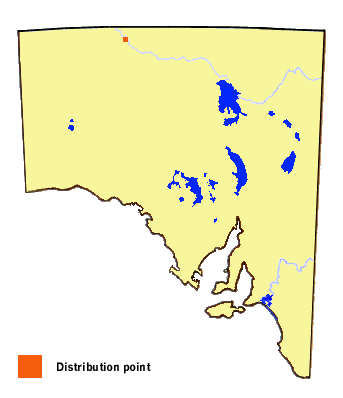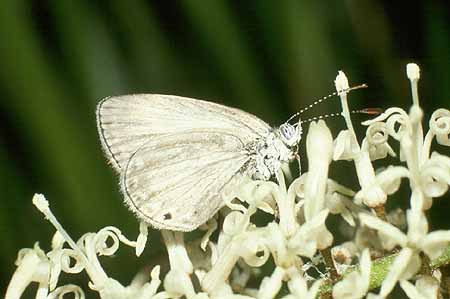-
Larval Food Host
-
Larvae utilise small Fabaceae legumes including Galactia tenuiflora,
Indigofera species (indigo), Vigna lanceolata (maloga bean).
The larvae feed on the buds and flowers of the hostplants.
-
Larval Attendant Ant
-
Larvae are attended by a few ants including Camponotus sp (extensus group),
small Iridomyrmex sp (including gracilis and rufoniger groups),
large meat ants Iridomyrmex purpureus, and Rhytidoponera metallica.
-
Eggs
-
Small, initially pale green, later turning bluish white, hemispherical, strongly
flattened top and bottom, slightly depressed on top with a small darker central
micropylar area. Ornamented with a coarsely reticulated pattern on the side which
becomes finer on top. The reticulation facets on the side are mostly trapezoidal.
The facets on the top of the egg are much smaller and are of irregular shape.
There are short, thick, blunt spines at the pattern intersections on the side
of the egg, which are reduced in size or absent on the top of the egg. Laid singly
on the hostplant, usually on the flower buds and sides of the open flowers, but
sometimes on the young terminal leaf growth.
-
Larvae
-
The mature larvae are about 10 mm long, onisciform (slater shaped) with a longitudinal
thoracic dorsal furrow. The head is small, smooth, yellowish brown, hidden beneath
the body. The posterior dorso-lateral organs are well developed. The anterior, posterior
and peripheral parts of the body are hairy, which are longest anteriorly and posteriorly,
and the body is covered in numerous, pale coloured, minute secondary setae having a
stellate base and a long erect serrated and pointed central spine. The secondary setae
impart a scabrous appearance to the larvae. Larvae colour and markings are variable,
pale green or pinkish green, with a longitudinal purplish dorsal line and adjacent
forward directed purplish chevrons, with further pale yellow subdorsal markings.
The colours are cryptic, matching the green calyx of the flower, and larvae feed openly
during the day. The presence of larvae on the hostplant are readily discernible by holes
in the buds and flowers. Small ants are usually indicative of the position of actively
feeding larvae.
Larvae prefer to eat the pistil and stamen parts of the flowers and buds. They make a hole
in the side of the bud and then extend the head to eat out the inner contents of the bud.
-
Pupae
-
Short cylindrical, rounded anteriorly and posteriorly, about 8 mm long, mostly smooth
but with short bristles. Greenish brown coloured, with darker brown cryptic markings.
Attached by anal hooks and a central girdle, to a leaf on the hostplant, or within
the congested flower head part of the hostplant. The pupal period is variable, and
can be as short as 6 days, but it is possible it may also undergo diapause in the
Far North of South Australia until the next blooming of its hostplant.
-
Flight Period in South Australia
-
The only South Australian records are for early October. In the nearby Alice Springs area,
further to the north, it has also been seen flying in early October. In this region it
would seem the butterfly flies after winter rains, which promote the reliable growth
and flowering of the larval hostplants. The butterfly is seen all year round in the
tropical north of Australia.

-
Distribution
-
This butterfly has only recently (2000) been reported from South Australia, where it was
found flying in the ephemeral creek systems in the extreme Far Northwest of the state.
Its small flowering leguminous hostplants are widely distributed in the far north pastoral
areas of South Australia, particularly in the ephemeral river systems, and so there is a
good chance that further records of the butterfly will eventuate.
The butterfly probably has some degree of nomadic dispersal ability (typical of the
Polyommatini group of lycaenids), with breeding stocks being periodically replenished
from interstate northern tropical areas after good rains and floods, with the butterflies
following the major creek lines down into northern South Australia. The butterfly
occurs more commonly in the humid tropical north of Australia. The butterfly also
extends throughout much of the eastern part of tropical Southeast Asia.

-
Habitat
-
In South Australia this butterfly has only been found in the ephemeral creek
systems in the semi-arid extreme Far Northwest of the state.
-
Conservation Status in South Australia
-
Presently classed as rare in South Australia. It is a locally common butterfly
in the tropical north of Australia.
-
Threats
-
Not much is known about the habits and distribution of the butterfly in South Australia.
Its continued survival in the region is likely to be dependant on the occurrence of
reliable rains in the central Australian Region. Cattle grazing and trampling would be
the main threat to established colonies.
-
Conservation Strategy
-
None required.


